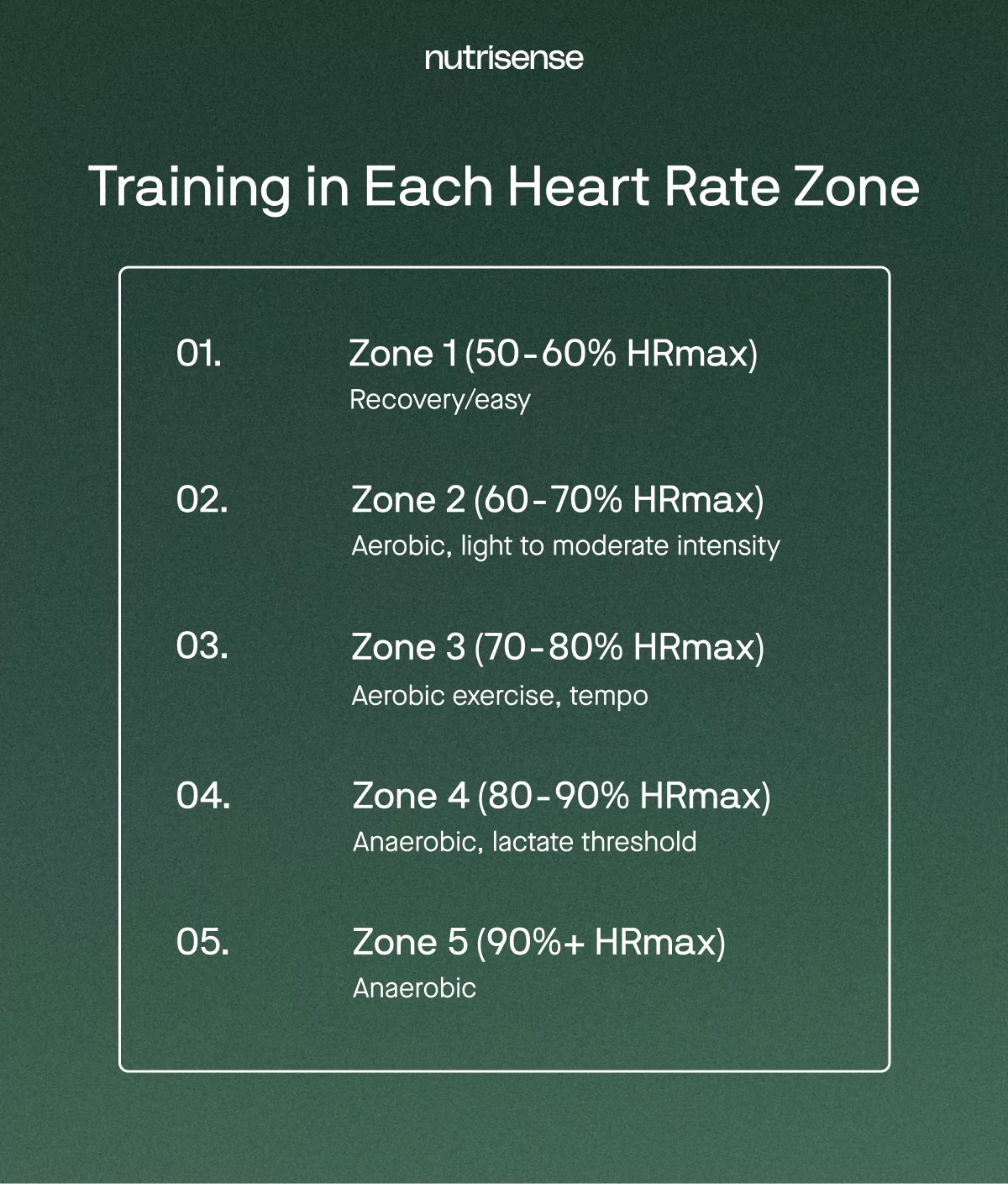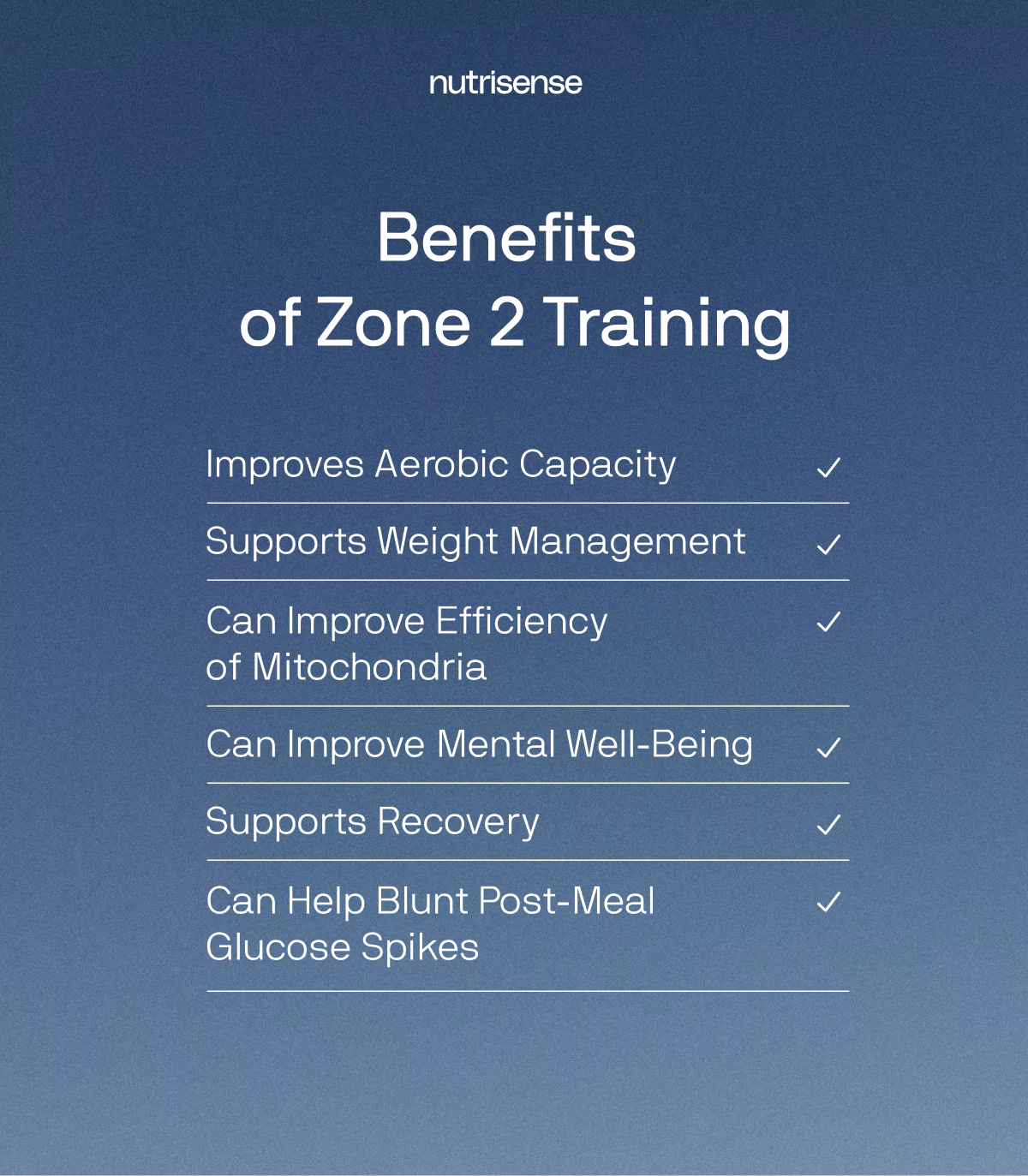Zone 2 Training: Maximizing Cardiovascular Benefits

Key Takeways
You’re probably familiar with the phrase “getting your heart rate up” when it comes to exercise. But why is your heart rate so important for running, swimming, or lifting weights, anyway?
When your heart rate is up, this simply means that your body is pumping blood and oxygen to your muscles. During exercise, your heart will start to beat faster and move into one of five heart rate zones depending on the kind of workout you’re doing.
And, while all intensity levels can have their place in any workout routine, there’s one zone in particular that hits a sweet-spot between physical demand and the metabolic returns it may offer: zone 2. Read on to learn everything you need to know about your heart rate during exercise and the benefits of zone 2 training.
What is Heart Rate Training?
Heart rate training refers to exercise that’s deliberately aimed at reaching and maintaining a specific heart rate. Heart rate can be thought of as a spectrum from resting heart rate, or RHR, to maximal heart rate, or HRmax.
Between your resting heart rate and max heart rate, there are five zones of heart rate training.

The zones go upward in intensity from one to five:
- Zone 1 (50-60% HRmax): Lower intensity movements, mostly warm-up and cool-down exercises.
Zone 2 (60-70% HRmax): Moderate activity, with potential manageability for longer periods. - Zone 3 (70-80% HRmax): Aerobic exercise, higher intensity training than zone 2, but more difficult to sustain for longer periods.
- Zone 4 (80-90% HRmax): Intense anaerobic exercise that builds muscle, such as weight lifting.
- Zone 5 (90%+ HRmax): Exercises and drills performed at maximal exertion for short periods of time.
Zone 5 Training Benefits
Zone 5 training refers to a high-intensity exercise zone often associated with anaerobic efforts, where athletes push themselves to near maximum effort for short durations. This training zone is characterized by its focus on improving peak power, speed, and anaerobic capacity. Contrary to zone 2 training, workouts in zone 5 typically involve intervals or sprints, helping enhance cardiovascular fitness and overall athletic performance.
What is Zone 2 Training?
Put simply, zone 2 training is aerobic exercise; the part where your heart rate is up, you’re sweating but you’re not tiring yourself out completely. Almost any moderate intensity cardio-oriented exercise, whether it’s:
- Brisk walking
- Jogging
- Swimming
- Cycling
In zone 2, your body may use glucose, fatty acids, or protein as a fuel source. In higher intensity anaerobic workouts, your body predominantly uses stored ATP, creatine phosphate, and glucose. Zone 2 training has been shown to increase an individual's metabolic threshold, which in turn may increase their oxygen uptake during exercise. This type of training can also help to increase the amount of energy you can expend before becoming tired and sore.
Metabolic Health Benefits of Zone 2 Training

Zone 2 training—which, to be fair, really just means moderate intensity aerobic exercise—has a whole array of different health benefits on offer. From its fat-burning potential to its effects on aerobic capacity, zone 2 training absolutely deserves a place in your workout routine.
Here are a few of the more noteworthy benefits of zone 2 training and why you should add it to your workout routine.
1) Improves Aerobic Capacity
Zone 2 training is shown to increase maximal oxygen uptake, or VO2 max, which is considered a key indicator of aerobic capacity. It has to do with how the body uses oxygen, affecting physical performance in general.
Moderate intensity exercise is a great way to enhance your aerobic base, assist with higher intensity training, and improve your athletic performance over time. It also possesses a number of benefits for your overall cardiovascular health.
2) Supports Weight Management
Many forms of physical activity can support weight reduction or healthy weight management. Though some might believe that zone 2 training is superior in reducing body fat compared to higher intensity workouts, studies don’t necessarily support that belief.
According to the American College of Sports Medicine, long-term moderate aerobic exercise for >150 or 200–300 minutes per week can significantly reduce body weight when the diet is not controlled. However, one randomized controlled trial reported that high-intensity interval training may be equally effective in reducing body weight and body fat as was low-intensity endurance exercise training.
Fat oxidation—how your body breaks down fat and turns it into energy—is at its highest when exercise intensity is low to moderate, about 45 to 65 percent of your VO2 max. However, your body will still be burning some carbs here. When fat is oxidized, it requires glucose for its full breakdown and utilization.
3) Supports Recovery

Exercise of a higher intensity, where the body’s demand for energy and oxygen exceed its supply, leads to lactate accumulation in your muscle fibers. This in turn leads to feelings of fatigue, which limit the body’s energy output during a recovery period.
Zone 2 training is shown to increase an individual’s oxygen uptake without a corresponding buildup in lactate. This means it’s useful, not only in and of itself, but also for improving your capabilities when it comes to more vigorous workouts in the higher heart rate zones.
4) Can Improve Mental Well-Being
Zone 2 training may be just the thing you need to start feeling better, both physically and mentally. Moderate intensity exercise of the sort encapsulated in zone 2 training is shown to have a significant positive impact on feelings of depression and anxiety.
Whether on its own, or in conjunction with other therapies, regular moderate intensity exercise is shown to have anti-inflammatory effects on the brain, while also promoting neuroplasticity—enhancing the brain’s ability to adapt and change its activity.
5) Improves Insulin Sensitivity

Insulin sensitivity describes how receptive the body is to the effects of the hormone insulin. In insulin resistant individuals, the body struggles to effectively use insulin to metabolize glucose, leading to dysregulations in blood sugar.
Luckily, research shows physical activity may help increase insulin sensitivity. This is another area where zone 2 training may shine—according to studies, moderate intensity exercise may be directly linked to improvements in insulin sensitivity to a greater degree than more vigorously intense aerobic activity.
That being said, the benefits of other types of exercise, including strength training, for insulin sensitivity should not be minimized. A 2019 study published in the Journal of Experimental Physiology found that short-duration resistance training results in an increase in insulin sensitivity.
6) Can Improve Efficiency of Mitochondria
Mitochondria, or the powerhouse of the cell, play an essential role in energy production. They’re the part of a cell responsible for converting broken down carbohydrates and fats into something called Adenosine Triphosphate, or ATP.
ATP is the body’s main source of cellular energy, the fuel for a number of essential functions in the body, such as muscle contraction. Mitochondrial function is very closely associated with insulin sensitivity, as well as with maximal oxygen uptake (VO2max)—a key indicator of aerobic fitness.
Aerobic exercise is shown to improve mitochondrial function to a significant degree. Studies show that such improvements are most pronounced in the moderate training zone—what we mean by “zone 2”—whereas at higher intensities, mitochondrial function may actually become impaired.
But don’t forget that optimal mitochondrial function also relies on well-balanced nutrition! Having adequate B vitamins, vitamin C, zinc, and essential fatty acids is very important.
7) Can Help Blunt Post-Meal Glucose Spikes

Studies show that moderate exercise has a beneficial impact on insulin sensitivity and blood glucose levels. But more specifically, exercising in the form of zone 2 training is associated with improvements in blood glucose control and fasting blood glucose.
In a 2023 systematic review and meta-analysis, researchers found zone 2 forms of exercise such as walking have a significant beneficial impact on postprandial hyperglycemia when undertaken as soon as possible after a meal.
Is Zone 2 Training Best for Fat Loss?
There’s not much evidence to suggest that higher intensity training is more or less effective than moderate intensity exercise when it comes to losing weight and burning fat. Generally speaking, it’s difficult to say whether zone 2 training is specifically better for fat loss than other intensities of exercise.
There are clear advantages to prolonged moderate intensity training over intermittent high intensity exercise, especially for endurance athletes. However, both are shown to be effective when it comes to reducing body fat percentage and managing weight over time.
Ultimately, it comes down to the individual—to their level of fitness, exercise tolerance, and whether they can successfully maintain a certain training plan.
How Can You Calculate Your Heart Rate Zones?

So, if you want to get started with zone 2 training, you may be wondering how easy it is to determine your own training zones. The first step is to find your own maximal heart rate (HRmax).
Research points to the Fox equation as the safest bet for self-calculating your HRmax. It’s quite a simple formula, so no need for advanced mathematical knowledge—it’s simply: HRmax = 220 - your age. From there, it’s just a matter of taking each zone’s percentage of your HRmax value to find out your target heart rate for each zone of training.

How to Start Zone 2 Training
Zone 2 can be a great option for people at all levels of physical fitness. After calculating your maximum heart rate, simply determine your target heart rate for zone 2, which should be between 60-70 percent of your HRmax.
Then, to make sure you’re training in this zone, you can use a wearable smartwatch or heart rate monitor to track your heart beat, or take your pulse manually. If taking your pulse sounds like a little too much trouble in the middle of an exercise, you can also try the “talk test” to make sure you can comfortably speak while performing your exercise.
Whether it’s jogging, cycling, swimming, rowing, or even brisk walking, aim to maintain a sub-strenuous pace for a period of about thirty minutes for an effective zone 2 workout.
Precautions and Considerations
As with any exercise routine, zone 2 training should always be performed with careful attention paid to your own body’s tolerance to avoid injury. Fitness isn’t one-size-fits-all, and it’s always better to start slow and work your way up.
If you’re looking to get started with a new workout routine, consider consulting with a healthcare or sports medicine professional first. Make sure that your exercise plan is suitable for your fitness level and takes into account any pre-existing health conditions that might prohibit you from certain exercises.
Key Takeaways
- Zone 2 training, or sustained moderate intensity aerobic exercise, has an array of potential health benefits.
- This type of training can help with weight management, building aerobic fitness, improving your mental well-being, improving insulin sensitivity, and regulating glucose response.
- Exercising in zone 2 is about steadiness and consistency, not maximal exertion.
- It’s easy on the body, friendly to the exercise-shy, and full of potential long-lasting health benefits to improve your well-being.
Find the right Nutrisense programto turn insight into progress.
Go Beyond Glucose Data with Nutrisense
Your glucose can significantly impact how your body feels and functions. That’s why stable levels are an important factor in supporting overall wellbeing. But viewing glucose isn't enough. Nutrisense, you’ll be able to learn how to use your body's data to make informed lifestyle choices that support healthy living.
One-to-one coaching
Sign up to access insurance-covered video calls to work with a glucose expert: a personal registered dietitian or certified nutritionist who will help tailor your lifestyle and diet to your goals.
Monitor and measure what matters
With the Nutrisense CGM Program, you can monitor your glucose with health tech like glucose biosensors and continuous glucose monitor (CGM)s, and analyze the trends over time with the Nutrisense App. This will help you make the most informed choices about the foods you consume and their impact on your health.
Find your best fit
Ready to take the first step? Start with our quiz to find the right Nutrisense program to help you take control.

Heather is a Registered and Licensed Dietitian Nutritionist (RDN, LDN), subject matter expert, and technical writer, with a master's degree in nutrition science from Bastyr University. She has a specialty in neuroendocrinology and has been working in the field of nutrition—including nutrition research, education, medical writing, and clinical integrative and functional nutrition—for over 15 years.




